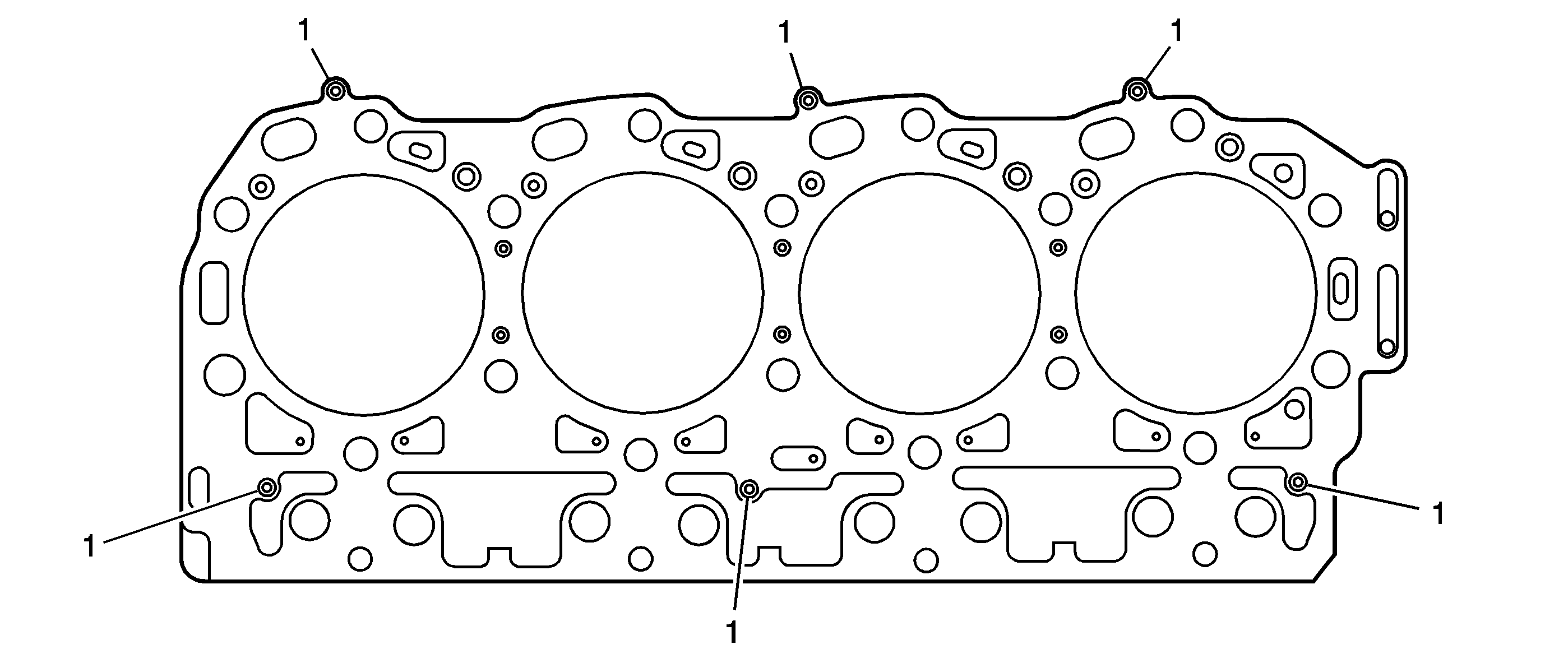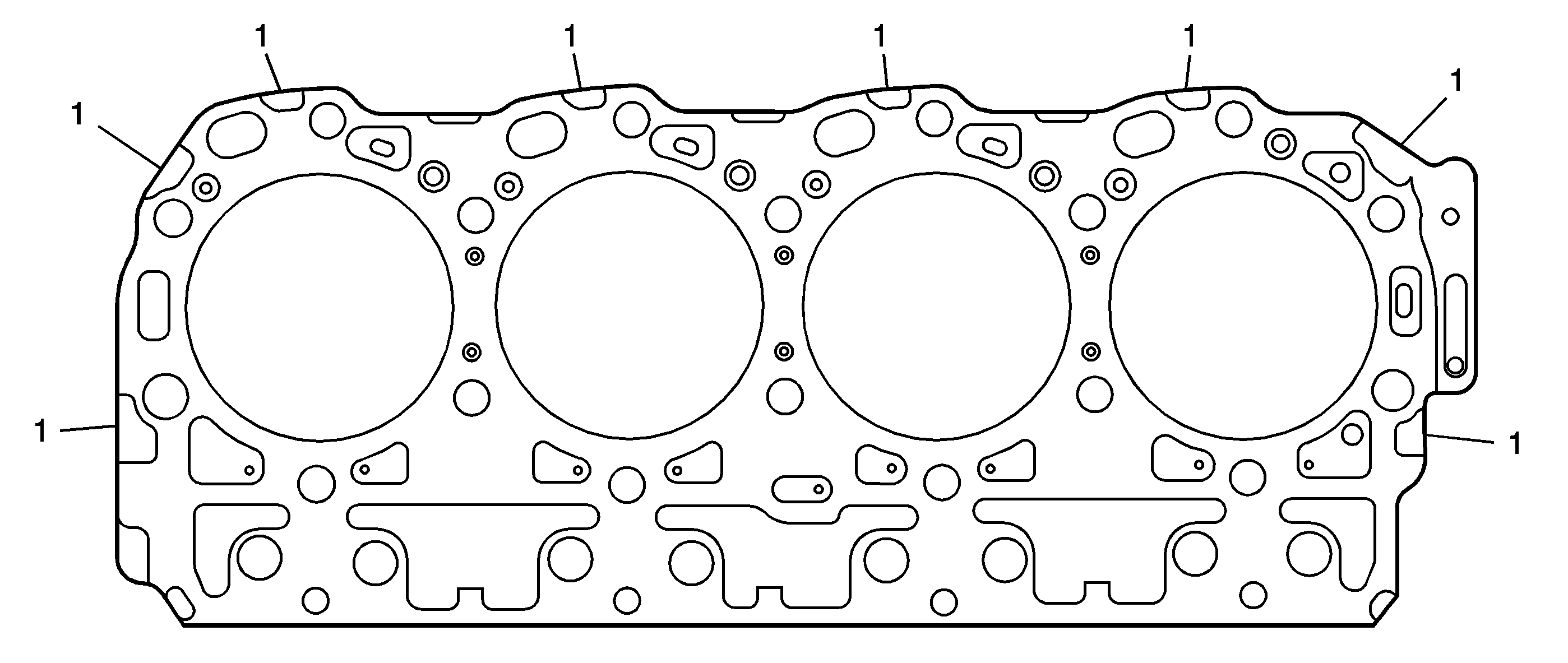Information on 6.6L LBZ, LB7, LLY Duramax Diesel Engine Cylinder Head Gasket Design Change - New Head Gasket Part Numbers and Head Bolt Torque Specifications

| Subject: | Information on 6.6L LBZ, LB7, LLY Duramax® Diesel Engine Cylinder Head Gasket Design Change -- New Head Gasket Part Numbers and Head Bolt Torque Specifications |
| Models: | 2001-2006 Chevrolet Silverado |
| 2003-2006 Chevrolet Kodiak C4500/5500 Series |
| 2006 Chevrolet Express |
| 2001-2006 GMC Sierra |
| 2003-2006 GMC TopKick C4500/5500 Series |
| 2006 GMC Savana |
| with 6.6L Duramax® Diesel Engine (VINs D, 1, 2 -- RPOs LBZ, LB7, LLY) |
This bulletin is being revised to inform dealerships about missing head gasket thickness grade marks. Please discard Corporate Bulletin Number 06-06-01-006A (Section 06 -- Engine/Propulsion System).
Important: If a cylinder head gasket is found to be absent of thickness grade markings, refer to Service Bulletin 07-06-01-009 for gasket identification.
A mid-year design change was made to the head gasket of the 2006 Duramax Diesel engine in December, 2005. This second generation gasket will service all 2001-2006 vehicles, including those with engines built using first generation gaskets. The second generation gasket will require a lower head bolt torque angle specification as well as special cleaning methods of the gasket surfaces.
Gasket Identification
The second generation gasket can be visually identified by its riveted construction, as opposed to the crimped design of the first generation gasket.
Second Generation Head Gasket (Riveted Construction)

Refer to the above illustration number (1) showing riveted construction.
First Generation Head Gasket (Crimped Construction)

Refer to the above illustration number (1) showing crimped construction.
Special Cleaning Requirements
For 2001-2006 vehicles produced with the first generation head gasket, special attention must be given to the cleaning of the engine block and cylinder head surfaces when servicing with a second generation gasket. The crimped areas (1) on the first generation gasket may, over time, allow corrosion buildup where they contact the block and cylinder head surfaces. The second generation gasket has raised ribs that seal at these crimped areas (1). A special cleaning procedure is required to ensure proper sealing.
Cleaning Procedure
- Remove the old head gasket using service manual procedures. Save the gasket for reference until the repair is completed.
- Place clean rags in the cylinder bores and pushrod openings in order to keep out debris.
- Use the J-28410 or equivalent to carefully clean the gasket sealing surface of large sealing or corrosion matter. When scraping, take care not to scratch or gouge the metal surfaces. Do not push the debris into oil, coolant, and combustion openings or bolt holes.
- Inspect the gasket sealing surfaces for corrosion, especially in the areas that were in contact with the crimped tabs of the first generation head gasket. If corrosion is present, continue with the rest of the steps in this procedure for proper cleaning. If the sealing surface is sufficiently clean and smooth, use the revised torque specification listed towards the end of this bulletin and continue with published service manual procedures to complete the repair.
- For surfaces that have corrosion or pitting, wrap a piece of flat steel (4"x 2" or larger) with 600 grit wet grade sand paper. Using Moisture Displacing Lubricant, P/N 88862629 (in Canada, use 89020803) or equivalent, wet sand the block surface to remove any remaining gasket material or corrosion. Do not use any paper coarser than 600 grit.
- Take care to keep the sanding block parallel to the block surface and evenly sand the sealing surface. Some areas of corrosion will still show a stain. Do not attempt to wet sand these areas down to a shiny metal surface.
- Change the sanding paper when it becomes clogged. Carefully and frequently wipe the surface, using a clean cloth each time, to prevent sanding debris from building up and contaminating the oil and coolant cavities.
- Clean the bolt threads and holes and remove the rags from the bore cavities and pushrod openings.
- Repeat the above cleaning procedure on the cylinder head gasket surface.
- Clean the engine block and cylinder head gasket surfaces with Brake Parts Cleaner, P/N 12378556 (in Canada, use 88901247) or equivalent, to remove any traces of oil or debris.
- Using the revised head bolt torque specification below, reassemble the engine with NEW M12 cylinder head bolts according to service manual procedures.
Notice:
• Do not use any power type sanding devices. • Do not use a wire brush or wheel to clean gasket surfaces. • Do not use chemical cleaning agents on gasket surfaces.
Torque Specification Change
The second design head gasket requires a lower torque angle specification for the M12 bolts than the torque required by the first generation gasket. The M8 bolt torque remains the same for both designs. The M12 bolts on engines using the second generation head gasket should be torqued using the angular tightening method to the following specifications:
M12 Bolt | 1st Step | 50 N·m (37 lb ft) |
2nd Step | 80 N·m (59 lb ft) | |
3rd Step | 60 Degrees | |
4th Step | 60 Degrees |
M8 Bolts | 25 N·m (18 lb ft) |
Important: SI will be updated with the revised torque specification.
Parts Information
Part Number | Description | Qty |
|---|---|---|
98045055 | Gasket, Cyl Hd, (Grade A) - RH | 1 |
98045056 | Gasket, Cyl Hd, (Grade B) - RH | 1 |
98045057 | Gasket, Cyl Hd, (Grade C) - RH | 1 |
98045058 | Gasket, Cyl Hd, (Grade A) - LH | 1 |
98045059 | Gasket, Cyl Hd, (Grade B) - LH | 1 |
98045060 | Gasket, Cyl Hd, (Grade C) - LH | 1 |
Warranty Information
For vehicles repaired under warranty, use:
Labor Operation | Description | Labor Time |
|---|---|---|
J0507 | Gasket, Cylinder Head - Both Banks - Replace | Use Published Labor Operation Time |
